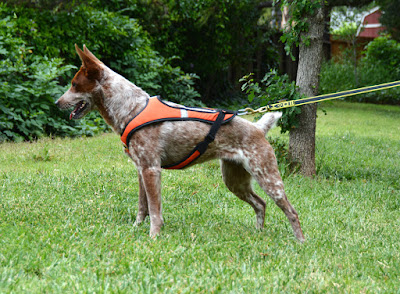1. Use a backpack.
This is my least favorite method of wearing out a dog on a walk. Strap a pack on your dog, weight it down with a couple of water bottles or cans of soup, and have him work harder. This is quite a popular idea in my area, but I dislike it because it gives the dog no choice. He's going to have to walk as far as you tell him to walk, and he's going to have to carry that pack the entire time. The weight puts additional stress on his joints, and can make him sore if the pack doesn't fit well. I think dog backpacks are great for backpacking and hiking and carrying useful things, but I dislike them being used purely to induce fatigue. |
| Photo by Erin Koski |
2. Mush!
Does your dog pull like a sled dog? Although polite leash walking is considered by many to be a crucial skill for a well-mannered dog, pulling is actually incredibly good exercise. Sometimes called "roading", pulling on leash is used to condition hunting dogs and canine athletes. It can be done with a very wide collar, but pulling is safest and most comfortable for the dog in a harness designed for the purpose. A sledding or mushing harness and a stretchy leash are easiest on your dog's body, and a wide belt is easiest on your own body. Best of all, pulling is a low-impact activity where your dog gets to decide how hard he's going to work. I allow my dogs to pull when they are wearing harnesses, but require them to walk politely on a collar.3. Play games.
There should be more than just a leash connecting you and your dog on a walk. Everyone needs some down time to sniff, but you can add some mental gymnastics for your dog to help make the whole outing more stimulating. I like teaching loose leash walking by making leash pressure into a cue for my dog to check in with me. Even after my dogs have mastered the skill of walking politely, I reinforce the behavior by occasionally giving the leash a little tug and rewarding them for looking at me. I also reward them for offering attention without being prompted, I like having a dog that occasionally looks back at me on a walk. When we see something exciting, like a skateboarder or another dog, I reward my dogs for looking at that thing, which turns scary or exciting things into cues to check in with me.
4. Interact with the Environment
Your daily walk can become a little adventure when you ask your dog to interact with the various objects that you pass. My current suburban neighborhood has a lot of small retaining walls and little short markers between the lawns, these are fun for my dogs to jump or stand on. Depending on where we walk, we might encounter low walls to balance on, rocks to sit and stay on, or park benches to crawl under. Even asking my dog to put her front paws on a fire hydrant or the low branch of a tree challenges her balance and makes her think. I might send her around a signpost, or ask her to touch her nose to a flower. Practicing her tricks with novel objects helps strengthen those behaviors, and provides a surprising amount of mental stimulation.Remember, a tired dog is a good dog, but it may take more than a simple walk around the block to tire your dog out. A flirt pole or springpole is a great way to get them some exercise in a small space, and you can fit quite a bit of exercise into that walk around the block if you try.
No comments:
Post a Comment